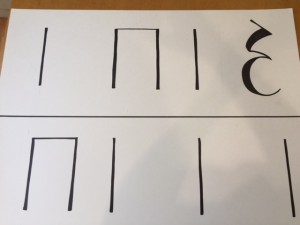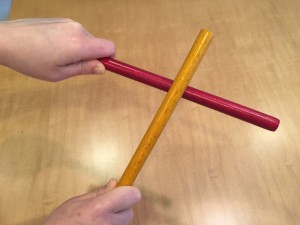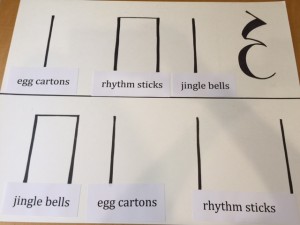
This poster is up at the front of the room. I tell the children, “Here is the pattern.” I immediately demonstrate it using rhythm sticks (even though the children don’t have theirs in hand yet and may not read music notation).
Patsch (the sticks gently hit your thighs once), click, click, click, (raise hands with sticks up and apart for the Rest).
“Do this rhythm with me.” The children follow me and do the pattern about two times when I begin to sing:
“My live is a gift….” as we continue to do the pattern. I sing and stop after I have sung the words “in heaven it began.”
“You’ve got the pattern enough to use the rhythm sticks.” I tell the children. “Remember, if you use these inappropriately, I take them. No questions asked. Your teachers will now pass out the rhythm sticks.” There is a bit of hub bub as each child gets two sticks from the adults that are helping to pass things out. As soon as even 1/3 of the children have sticks, I start the pattern again.
 “Patsch, click, click, click, rest!” I lead the children in the pattern until most of the children have their sticks. “Don’t get pulled off from this pattern as I sing the song!” We start the pattern, then I begin to sing, “My life is a gift…”
“Patsch, click, click, click, rest!” I lead the children in the pattern until most of the children have their sticks. “Don’t get pulled off from this pattern as I sing the song!” We start the pattern, then I begin to sing, “My life is a gift…”
We sing and do the pattern until I have sung the words, “to direct me from birth.” “Freeze!” I call out. “Now let’s do a new pattern.”
Click, click, click, patsch, patsch. (See the second rhythm pattern on the poster above.) Again we do the new pattern about two times, then I start to sing.
“I will follow God’s plan for me….” We continue to do that pattern as I sing clear to the end of the song.
(They are experiencing the beat and the flow of the music in their bodies. Because music is a great carrier of important words, it is great to have this experience with the body so that we can remember important words set to this rhythm and beat.)
Extender activity
“You have gotten this pattern down so well that you are ready for an extra challenge. We are going to do this same rhythm (pointing at the top rhythm on the poster) with some added instruments.” I ask the adults to pass out the jingle bells (or shakers) and the egg cartons to some of the children. They will be collecting the rhythm sticks from those children, except that the egg carton people will need one rhythm stick in order to play their egg carton. They will be scraping the rhythm stick along the bumps of the back of the egg carton. As the adults are passing out the other instruments, you will be putting up the following word strips:

Immediately jump in and start the activity, even if only half of the children have their new instruments. (Transitions are the places you lose children’s attention, so you make the transition quickly.)
“Egg cartons! Let’s hear you play to this beat. Beat, beat, beat, beat. Freeze!”
“Jingle Bells! Let’s hear you play to this beat. Beat, beat, beat, beat. Freeze!”
“If you are an egg carton player, you play here.” (point to the line) “If you are a rhythm stick player, you play here.” (point) If you are a jingle bell player, you play here.” (point) “Ready orchestra?”
I start the group out by pointing to their beat to the beat of the song for the top pattern. (I don’t point twice for the rhythm sticks even though they play two notes. I only point on the beat.) After they have practiced the top pattern twice, I start to sing, “My life is a gift….” We sing all the way to “…from birth.” I call out, “Switch to here!” And we play in the same beat pattern, but now on the lower pattern of the poster as I sing, “I will follow God’s plan for me….”
If there is time:
If there is time, have the children switch instruments with a friend. You will need the adults who passed out the instruments to give some guidance so that everyone gets a new instrument.
Sing the song, point to the beats, and play the rhythm band pattern once again. Have the children quickly pass in their instruments to the teachers. I will often count down from 15 at this point, to help “reluctant” children give up their instrument.<grin>
The beauty of this activity is that the children are moving in a purposeful way to a steady beat. That kind of movement helps the frontal lobe to develop and progress. It brings order to the brain. And… it’s fun! The children have heard the whole song at least two or three times while being super engaged. That engagement and participation opens up the brain to have the words slip in the back door, even though that is not what you are focused on. The attitude they associate with this song from the activity is energy, fun, and interest!

Donna Bevan
Is there anyway to make a printable copy of the rhythm poster? I just bought rhythm sticks to do this with and so excited to try it,but I have no way of making the rhythm chart. Can you help me?
Donna
Sharla Dance
Dear Donna, If I make an 8×11 size on the computer, the children won’t be able to see it. Would you be enlarging it? The reason I don’t have it on a computer is because I took a poster board and drew the straight lines with a ruler.
Laura
Maybe I missed something in the directions but I don’t understand the markings you use on the poster. I’ve never done this before but I think my SR primary would really get into this! Thanks for all you do. I am one of many that have been truly blessed by your talents!
Sharla Dance
Dear Laura, One line equals one sound on one beat, and two lines joined across the top are two sounds on one beat. The lines are like the one line of a quarter note, and the two lines joined are like two eighth notes joined. You just demonstrate the rhythm and don’t have to tell the children what they are. What they don’t know is that this is real rhythm markings from music so they are exposed to reading music without really knowing it! Thanks for asking. Please keep asking great questions like this. (And let me know if I wasn’t quite clear!)
I Will Follow God’s Plan for Me: Monthly Plan – Teaching Primary Music
[…] Rhythms with sticks, bells, and egg cartons […]
Leslie
I watched Sharla’s youtube video over and OVER until I got the patterns on the video. It really helped to understand how to do it. https://youtu.be/RG6G24RpC24 I am planning to do those.
Sharla, is there a reason you are doing a different pattern here than in the video that I should do the new one instead?
Sharla Dance
I’m grinning sheepishly. I often change the patterns from year to year so that I remain challenged and creative. Either pattern works. Thanks for asking!
Laura Bickmore
Quick question – are you having the egg cartons do a “thunk” beat like a drum, or a scrape like a homemade guiro?
And Sharla….
I LOVE YOU! We have so much fin in our primary with your activities! I did “Take in in, take it out” as an opening song activity with “If I Listen With My Heart” and Senior Primary sang so well!!!! I love that we can teach the songs without feeling like we are teaching them. 🙂
THANK YOU SO MUCH FOR YOUR HARD WORK!!!! <3 <3 <3 <3 <3
Sharla Dance
Dear Laura, I had them scrape (but thunks work, too!) Thank you for taking off and running with the different activities. You bless the children! And you bless me with your kind words…
Jessica
I’m going to be teaching my kids “I will follow God’s plan” this month (haven’t started yet since we had stake conference last week) and I want to do the rhythm activities. We combine for jr and sr, though. How would you recommend doing this?
I want the older kids challenged, so I thought about having the jr primary follow me and having the sr primary follow a chart. But I worry that having two separate rhythms playing while we sing might throw all the kids off, and distract too much from actually learning the song. What do you think?
Sharla Dance
Dear Jessica,
I would have the younger children do the rhythm activities on the beat (no matter what their instrument), being led by someone (like a teacher or even an older child). Then I would ask the older children to do the rhythm on the chart with you leading them. I would even turn my back to the younger side of the room, so they don’t follow you instead. I have some other ideas, too. I’ll write a post on it tomorrow! I’d love to talk to you, also. Take care, Sharla
pamela friske
I love love your ideas. thanks for helping me teach the children in creative and fun ways Sharla!
Sharla Dance
Dear Pamela, I’d love to hear some of your experiences. Take care, Sharla
Lori Huey
I did this with my senior primary yesterday. They thought it was challenging. Maybe it’s because I don’t have any rhythm myself so it was challenging for me. But they really liked it. I am planning on doing the extender activity next Sunday. Thank you for all your ideas.
Sharla Dance
Dear Lori, I’m grateful that you are willing to try and go for it. I often find I am challenged by singing, leading, and doing rhythm activities! The children are very forgiving of my mistakes .
Adrienne
Hi Sharla. What do you recommend using for rhythm sticks? I’m looking for something that fits the purpose and is also fairly inexpensive.
Sharla Dance
You can use dowels and just cut them. Lots of places sell rhythm sticks already painted. The less expensive are usually thinner and don’t sound as rich, but they still work.
chelsea maddux
I’m a little confused on the orchestra part. Do the kids with egg cartons just play the one quarter note and then rhythm sticks play the next two eighth notes with the bell playing the last note or do they somehow play all together?
Sharla Dance
Yes. They play only their “beat.” They are learning to wait their turn to play, learning to hear the beat in the music, concentrating to be able to come in at the right time (so the song is running through their head), and learning to work in a large group.
kim Larsen
Are there two different posters worth of rhythms? Or just the one pictured?
Sharla Dance
Just one. I added the words listing the different “instruments” to the same poster.